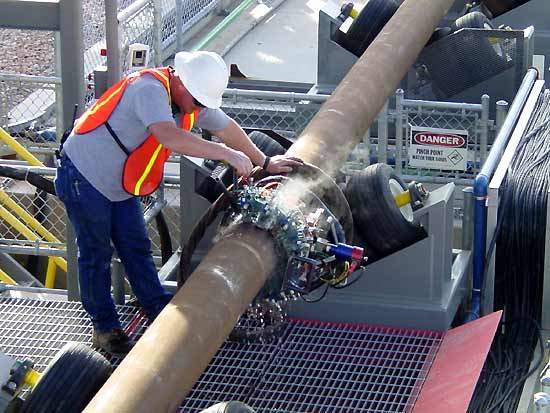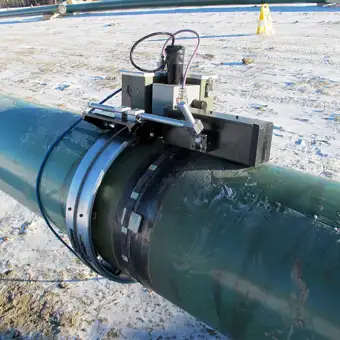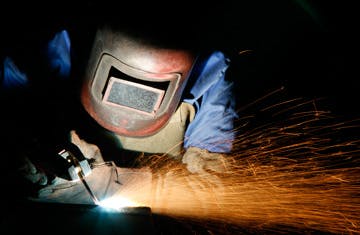Advanced Pipeline Welding Inspection: Strategies for Detecting Flaws
Advanced Pipeline Welding Inspection: Strategies for Detecting Flaws
Blog Article

Ideal Practices for Pipe Welding Assessment: Methods, Criteria, and Treatments to Accomplish Quality Control and Conformity
Effective pipeline welding examination is vital for ensuring the integrity and safety of critical framework. Comprehending the intricacies involved in each stage of inspection is important to achieving conformity and reliability in pipe systems.
Significance of Welding Inspection
The stability of welded joints is vital in making certain the security and dependability of pipe systems. Correct welding strategies and detailed examination processes are critical to stop failures that can result in catastrophic occurrences, environmental damage, and death. Pipeline Welding Inspection. Welding assessment serves as a preventive action, recognizing flaws such as cracks, porosity, and insufficient blend before they intensify into significant issues
Moreover, pipe systems commonly run under high stress and severe problems, making the top quality of welds a lot more crucial. Regulative compliance is another significant facet, as various standards dictate the quality control procedures that should be abided by in pipeline building and upkeep. Failing to conform can cause financial losses and legal implications.

The duty of welding examination prolongs beyond simple confirmation of craftsmanship; it incorporates the guarantee of long-lasting operational stability. This involves an organized technique that consists of not only visual assessments however also progressed non-destructive testing techniques. Eventually, reliable welding assessment is an investment in the longevity and safety of pipe systems, ensuring they work as meant while decreasing risks connected with product shortages.
Secret Assessment Strategies

Aesthetic evaluation, usually the first line of defense, enables for the recognition of surface area problems such as cracks, undercuts, and porosity. Ultrasonic screening employs high-frequency audio waves to spot interior imperfections, offering a thorough analysis of weld integrity. This non-destructive technique is specifically effective for recognizing gaps that might not show up on the surface area.
Radiographic screening entails using X-rays or gamma rays to produce photos of the bonded joint, disclosing interior issues. This technique offers detailed understandings however may require specific equipment and safety considerations. Last but not least, magnetic particle testing is efficient for discovering surface area and near-surface interruptions in ferromagnetic products, making use of electromagnetic fields and great iron bits.
Market Specifications and Regulations
Conformity with market requirements and policies is important for making sure the high quality and security of pipeline welding inspections. These standards give a structure for finest practices in welding procedures, materials, and evaluation techniques, permitting companies to reduce problems and enhance the honesty of pipe systems. Trick bodies such as the American Society of Mechanical Engineers (ASME), the American Welding Culture (AWS), and the International Organization for Standardization (ISO) state standards that are extensively acknowledged and taken on within the industry.
In the USA, policies from the Pipeline and Hazardous Materials Safety And Security Management (PHMSA) regulate the safety and security of pipeline procedures, mandating rigorous examination protocols. These criteria not only offer to secure public security and the atmosphere however also his explanation make certain conformity with contractual and legal responsibilities. Adherence to the relevant codes, such as ASME B31.3 for procedure piping, is vital for preserving operational effectiveness and regulatory compliance.
In addition, continuous updates and alterations to these requirements show technical innovations and developing market methods, emphasizing the need for companies to stay educated and train workers as necessary. Ultimately, robust compliance with established requirements cultivates trust and dependability in pipeline facilities, securing both properties and stakeholders.
Effective Evaluation Treatments
Reliable inspection procedures are essential for identifying prospective issues in pipeline welds and guaranteeing the general honesty of the system. An organized approach to inspection incorporates several key phases, consisting of pre-weld, in-process, and post-weld examinations. Each phase plays an important role in preserving top quality assurance.
During pre-weld inspection, it is important to assess the products and joint setups, making sure conformity with job specs. In-process examinations include keeping an eye on welding strategies and specifications, such as warm input and travel speed, to prevent flaws from happening. This phase enables real-time adjustments to welding techniques.
Post-weld assessments include non-destructive screening (NDT) methods like radiography, ultrasonic screening, and magnetic fragment testing. These techniques assist discover interior and surface area problems that might endanger the pipe's functionality. Documents of all examination tasks is critical, supplying a traceable document that supports conformity with industry criteria.
Training and accreditation of evaluation employees further boost the effectiveness of these procedures. By sticking to an organized inspection procedure, companies can minimize threats, guarantee conformity, and eventually provide pipelines that fulfill rigid safety and efficiency requirements.
Typical Difficulties and Solutions
Pipe welding assessment provides numerous common difficulties that can affect the top quality and safety and security of the end product. One substantial difficulty is the variability in welding methods and materials, which can bring about irregular weld quality. To resolve this, it is essential to develop standardized procedures and training for welders, ensuring an uniform approach across tasks.

Ecological variables, including temperature and humidity, can likewise influence the welding procedure, possibly leading to fractures or incomplete combination. Applying regulated environments and sticking to pre-weld procedures can minimize these dangers.
Conclusion
Finally, the application of finest practices for pipeline welding examination is vital for ensuring quality look here control and compliance with market criteria. A thorough strategy, including various techniques such as aesthetic, ultrasonic, and radiographic screening, promotes the recognition of issues throughout all phases of the welding procedure. Pipeline Welding Inspection. Adherence to developed guidelines and efficient evaluation treatments not only enhances the dependability and security of pipeline systems but additionally minimizes threats associated with welding issues, thereby promoting total operational stability
Compliance with sector requirements and policies is essential for ensuring the high quality and safety and security of pipe welding inspections. These requirements supply a structure for ideal practices in welding processes, materials, and assessment methods, permitting companies to minimize problems and improve the honesty of pipeline systems.In the United States, policies from the Pipeline and Hazardous Products Security Management (PHMSA) regulate the safety and security of pipe operations, mandating extensive assessment methods. A systematic approach to evaluation get redirected here encompasses several key phases, consisting of pre-weld, in-process, and post-weld examinations.In conclusion, the implementation of best practices for pipeline welding examination is essential for ensuring quality guarantee and conformity with sector requirements.
Report this page